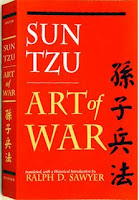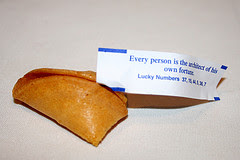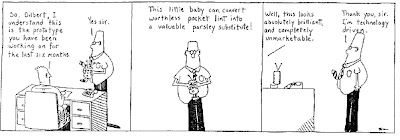Wednesday, October 31, 2007
Tuesday, October 30, 2007
Sun Zi Mindset: The Importance of Strategic Preparation (1)

The following article on Cheating in Online Poker emphasizes the lesson of "... Never enter the territory of the opposition without a superior advantage. "
###
From http://www.schneier.com/blog/
Cheating in Online Poker
http://freakonomics.blogs.nytimes.com/2007/10/17/the-absolute-poker-cheating-scandal-blown-wide-open/
Fascinating story of insider cheating: Some opponents became suspicious of how a certain player was playing. He seemed to know what the opponents' hole cards were. The suspicious players provided examples of these hands, which were so outrageous that virtually all serious poker players were convinced that cheating had occurred. One of the players who'd been cheated requested that Absolute Poker provide hand histories from the tournament (which is standard practice for online sites). In this case, Absolute Poker "accidentally" did not send the usual hand histories, but instead sent a file that contained all sorts of private information that the poker site would never release. The file contained every player's hole cards, observations of the tables, and even the IP addresses of every person playing. (I put "accidentally" in quotes because the mistake seems like too great a coincidence when you learn what followed.) I suspect that someone at Absolute knew about the cheating and how it happened, and was acting as a whistle- blower by sending these data. If that is the case, I hope whomever "accidentally" sent the file gets their proper hero's welcome in the end.
Then the poker players went to work analyzing the data -- not the hand histories themselves, but other, more subtle information contained in the file. What these players-turned-detectives noticed was that, starting with the third hand of the tournament, there was an
observer who watched every subsequent hand played by the cheater. (For those of you who don't know much about online poker, anyone who wants can observe a particular table, although, of course, the observers can't see any of the players' hole cards.) Interestingly, the cheater
folded the first two hands before this observer showed up, then did not fold a single hand before the flop for the next 20 minutes, and then folded his hand pre-flop when another player had a pair of kings as hole cards! This sort of cheating went on throughout the tournament.
So the poker detectives turned their attention to this observer. They traced the observer's IP address and account name to the same set of servers that host Absolute Poker, and also, apparently, to a particular individual named Scott Tom, who seems to be a part-owner of
Absolute Poker! If all of this is correct, it shows exactly how the cheating would have transpired: an insider at the Web site had real-time access to all of the hole cards (it is not hard to believe
that this capability would exist) and was relaying this information to an outside accomplice.
More details here.
http://forumserver.twoplustwo.com/showthreaded.php?Cat=0&Number=12523924&an=&page=0&vc=1
###
/// Quotes are from Griffith's translation of Sun Zi's AoW
Step 1: Know your target and know yourself
Therefore I say: 'Know the enemy and know yourself; in a hundred battles you will never be in peril. --- Chapter 3 – Offensive Strategy
Step 2: Decide to gather information
Now the reason the enlightened prince and the wise general conquer the enemy whenever they move and their achievements surpass those of ordinary men is foreknowledge. .... What is called 'foreknowledge' cannot be elicited from spirits, nor from gods, nor by analogy with past events, nor from calculations. It must be obtained from men who know the enemy situation. . .. And therefore only the enlightened sovereign and the worthy general who are able to use the most intelligent people as agents are- certain to achieve great things. Secret operations are essential in war; upon them the army relies to make its every move.
Step 3: Gather information on the target and the territory
Of all those in the army close to the commander none is more intimate than the secret agent; of all rewards none more liberal than those given to the secret agents; of all matters none more confidential than those relating to secret operations. -Chapter 13 Employment of Competitive Intelligence
Step 4: Determine the state of the territory.
In respect to the employment of troops, ground may be classified as dispersive, frontier, key, communicating, focal, serious, difficult, encircled, and death. ... Ground equally advantageous for the enemy or me to occupy is key ground. ... Do not attack an enemy who occupies key ground. ... In key ground I would hasten up my rear elements. - Chapter 11 Nine Grounds
Step 5: Plan and Decide.
"Now if the estimates made in the temple before hostilities indicate a victory it is because calculations show one's strength to be superior to that of his enemy; if they indicate defeat, it is because calculations show that one is inferior. With many calculations, one can win; with few one cannot. How much less chance of victory has one who makes none at all! By this means I examine the situation and the outcome will be clearly apparent.
Step 6: Lead by Prepositioning
Anciently the skillful warriors first made themselves invincible and awaited the enemy's moments of vulnerability. ... Invincibility depends on one's self; the enemy's vulnerability on him. ... It follows that those skilled in war can make themselves invincible but cannot cause an enemy to be certainly vulnerable. ... Therefore it is said that one may know how to win, but cannot necessarily do so. ... Invincibility lies in the defense; the possibility of victory in the attack. - Chapter 4 Disposition
Building the Tangible Vision is Step 1-4.
Connecting with the Tangible Vision is Step 5
Leading with the Tangible Vision is Step 6.
###
I highly recommend the translations from Sawyer and Ames. Also recommend Mark McNeilly's book on applying Sun Zi's principles. It comes with Griffith's translation.

###
--- More to come ---
Sunday, October 28, 2007
Achieving the Capitalist Dream

Today, I am presenting a different focus on our theme of collaboration. To achieve the capitalist dream, one always need a team.
No matter how successful one is, he/she always collaboratively need a team. ... Not everyone are leaders. Some are happy just being a team player.
First, one needs to know their role .
We start by asking the following questions:
1. Are you a collaborative team leader
2. Are you the team star that does the major work?
3. Are you the supporting team player?
Before one can ask those questions, he/she needs a 360 degree view of how the global game is played. The next step is the viewer must determine whether he/she has the objectivity, the experience and the drive to play the global game.
###
Age of Riches
After Succeeding, Young Tycoons Try, Try Again
By GARY RIVLIN
SAN FRANCISCO Max Levchin is not easily distracted from his work.
A few years ago, Mr. Levchin, one of the young princes of Silicon Valley, bought his first home, a 12-room Edwardian high atop a hill here, for $3.4 million. But Mr. Levchin, who made a fortune at age 27 selling PayPal, the online payment service he helped start in 1998, never moved in. He sold it two years later without having slept there for even one night.
Since then, Mr. Levchin has moved into his second home, a more expensive one found for him by Nellie Minkova, his girlfriend of eight years who has become his fiancée. But so consumed is he by work on his second company, an Internet start-up focused on sharing photos and videos, that the cartons that contain what Mr. Levchin described as 85 percent of my worldly possessions are still stacked in his living room, five months after moving day.
Mr. Levchin, who is now 32, is typical of a new generation of junior titans in Silicon Valley who might be called the prematurely rich techies worth tens of millions of dollars, sometimes more, at an age when many others are just starting to figure out what to do with their lives.
The Internet, a low-overhead medium with a global reach, has greatly accelerated the wealth creation phenomenon, producing a larger breed of multimillionaires even younger and richer than in the past.
They are happy to be wealthy, of course, but many of these baby-faced technology tycoons often seem indifferent to the buying power of their money, at least at this stage of their lives. Instead, nearly all of them have chosen to throw themselves back into a start-up, not so much because they want a spectacular new home or a personal jet though many of them do but because they are in a competition with themselves and one another.
For most of us, doing it again means surpassing what we’ve done previously, said Peter A. Thiel, Mr. Levchin’s partner at PayPal, who also has started a new business, a hedge fund called Clarium Capital. And that can be a really high bar.
Even among this jittery group of overachievers, Mr. Levchin stands out. In part that is because outdoing PayPal may be an all-but-impossible goal. Mr. Levchin acknowledges that he has already earned more money than he could ever spend. But he said he would not consider Slide.com, the photo and video sharing site he founded in 2005 that is still in its start-up phase, a success unless it is ultimately worth, in real dollars, at least $1.54 billion the price eBay paid for PayPal.
Otherwise, he asked rhetorically, what have I learned?
During his PayPal days, Mr. Levchin was so committed to seeing the company succeed that he often sacked out at the office in a sleeping bag he kept under his desk. Considering that he described his apartment during some of this time as scary, that had a certain logic. Cardboard boxes served as his living room furniture; a discarded computer desk was his dining room table.
These days, despite the phenomenal success of PayPal, which gave him the bulk of a fortune worth around $100 million, Mr. Levchin continues to work an average of 15 to 18 hours a day.
We occasionally go out to eat, he sleeps a few hours, he works out, Ms. Minkova said. But other than that, Max works.
Ms. Minkova half-joked that she might appreciate her occasional evenings out with Mr. Levchin more, if only he were not on his BlackBerry, answering e-mail messages and checking his Web site.
One friend, Dennis Fong, who sold a company to MTV Networks last year for $102 million (and is already at work on a new start-up), talks about the weird growling sound that Mr. Levchin tends to make when someone even mentions the name of his chief rival, RockYou.
And so committed is Mr. Levchin to seeing Slide.com succeed that he keeps a blood-pressure monitor on his desk. I don’t know what I would do if I couldn’t start companies, he said. I’d probably think about slitting my wrists.
Wealthy at a Young Age
Maximillian Rafael Levchin was born and raised in Kiev, Ukraine, a Jew living under Soviet rule for 16 years. As the Soviet Union was crumbling, the family moved to the United States and settled in Chicago. But the worst year of his life, he said, was not when he was growing up but after eBay bought PayPal.
He thought he would spend the time after the sale exploring my inner self. Instead, he spent the better part of 12 months feeling worthless and stupid and baffled by what he might do with the remainder of his life. He felt too young to retire or downshift a gear or two and too restless to become a philanthropist.
I enjoy sitting on nice beaches and hanging out with my girlfriend and playing with my dog, but that’s three hours a day, Mr. Levchin said. What about the remaining 18 hours I’m awake?
At first, free time was not much of a problem. Coming into a lot of money at a very young age, Mr. Levchin found himself forced to ponder things like irrevocable trusts and secondary beneficiaries. Several times a week, he would listen to the gentle hectoring of older, well-dressed men and women whom he playfully mimicked, employing a basso profondo, game-show announcer’s voice.
Think of the kids you don’t have, Mr. Levchin quoted them as saying. Think of your unborn grandkids.
As those obligations of his new wealth subsided, Mr. Levchin contemplated what he might do next. For a time, Mr. Levchin, a graduate of the University of Illinois at Urbana-Champaign, thought about returning to school and earning a doctorate. That is what his mother, a physicist, had always wanted him to do, and it seemed to suit his temperament.
But discussions with a friend who teaches computer science at Stanford convinced him that academia was not the life for him. This friend said, ‘Don’t kid yourself, you’re going to start another company,’ Mr. Levchin said. It was one of those things where as soon as he said it, I knew it was true.
He thought, too, about becoming a venture capitalist or an angel investor, a well-paved path for generations of entrepreneurs before him. Sequoia Capital, one of Silicon Valley’s top venture firms, gave him a desk to use while he figured out his next step. The partners at Sequoia would regularly invite him to join pitch meetings, but that experience taught him that he was hardly suited to the more nurturing side of the profession.
I took this perverse pleasure in seeing if I could make someone cry, he said.
At Sequoia, Mr. Levchin met James Hong, another successful entrepreneur who today is one of his closest friends.
We’d go out drinking, and Max’d talk about how miserable he was, and I’d talk about how miserable I was, said Mr. Hong, who was 27 when he and a friend started HotOrNot, a Web site popular with the under-30 crowd.
Mr. Levchin added, We were both pretty pathetic.
While not nearly as rich as Mr. Levchin, Mr. Hong describes himself as well off enough so that work is optional. He was collecting more than $1 million a year from HotOrNot, a project he and his partner had created in seven days and which demanded little of his time.
All of a sudden, you have the luxury or the curse of being able to ponder the meaning of life, Mr. Hong said. You ask yourself, ‘Why am I not happier given how lucky I’ve been?’
Only later did Mr. Hong diagnose the real source of his angst: he was not doing much of anything. So like most of his peers, Mr. Hong decided to throw himself back into work, in his case refocusing on HotOrNot in the hopes of transforming the Web site into a larger business.
In Silicon Valley, said Robert I. Sutton, a professor of management science and engineering at Stanford and co-founder of the Stanford Technology Ventures Program, remaining relevant, if not also admired and respected, requires that an entrepreneur continue to speed along in the fast lane.
In other parts of the country, things like a great estate are the symbols people most respect, Mr. Sutton said. But here, the greatest status symbol is a person’s ability, he added, to still bring out hot new companies and show that you are working on the hot new technologies.
Some, of course, choose to step off the start-up merry-go-round. Pierre Omidyar, 40, the founder of eBay, remains chairman of that company, but he gave up the day-to-day operations in the late 1990s. Since that time, Mr. Omidyar, who has a net worth of $9 billion, has devoted most of his work energies to philanthropic causes and investments in projects in the United States and in the developing world.
Mr. Levchin concluded that his competitive drive was too strong for that kind of life. During his time off, he competed with Mr. Hong over who was the more frugal of the two and challenged him to push-up contests at the gym. No matter how many I’d do, Mr. Hong said, he’d have to do that many plus two.
So Mr. Levchin did what any young titan in his position might have done. He dipped into his deep reserves of cash to pay for a large loft space and hired a half dozen of the smartest computer programmers he knew.
I knew I wanted to be a C.E.O., Mr. Levchin said. I just didn’t know the C.E.O. of what.
Readying for the ‘Next Race’
Mr. Levchin proved vigorous in his pursuit of the right start-up. There are those in Silicon Valley who still create new companies out of a desire to crack a challenging technical problem. But not Mr. Levchin, who, like many of the area’s most highly regarded software engineers nowadays, views himself as the creator of potentially lucrative businesses more than simply the architect of a nifty new technology.
It’s easier to start the next company than it was in the past, said Marc Andreessen, who was a co-founder of Netscape Communications in 1994, when he was 22. It is also potentially more lucrative than it was even a dozen years ago, said Mr. Andreessen, who despite a net worth estimated to be in the hundreds of millions of dollars is now at work on his third start-up, a social networking company called Ning.
For the first time in history, you have a global market of 1 billion-plus people, all connected over an interactive network, Mr. Andreessen said. The opportunities are bigger than ever before.
A site for sharing photos and video was not necessarily Mr. Levchin’s favorite among the dozen or so ideas he pondered. But he chose Slide.com precisely because he thought it had the greatest potential to become a business that could surpass PayPal in size and reach.
In 2005, when he started Slide, the Internet already had plenty of popular photo-sharing sites, but Mr. Levchin saw a new way to cash in on the desire of so many to express themselves in cyberspace: a service that gives people an easy way to dress up their blogs and personal pages with photo slide shows, videos and the like.
Facebook users, for instance, use Slide-produced playthings like its multimedia FunWall or the SuperPoke widgets that let them hug or punch a fellow member (figuratively speaking) or even throw a virtual sheep at someone (as apparently 20,000 people an hour choose to do, according to Slide).
More than 130 million people viewed at least one Slide multimedia presentation in June, according to the Internet traffic monitor ComScore.
I’d run any company; it’s completely irrelevant to me, Mr. Levchin said. It’s really about this drive to win.
Yet what Mr. Levchin calls my particular brand of obsession comes with a cost. He wishes he gave more to charity, but he can never seem to find the time. It’s pathetic how much I give compared to other people I know worth considerably less, he said. And his desire to earn even more means he pays little attention to the wealth he already has in the bank.
This ‘next race’ attitude really shapes your brain, Mr. Levchin said. It’s ‘Ready, set, go,’ and nothing else really matters.
The three-story, five-bedroom house he shares with Ms. Minkova cost him $5.3 million, but it seems to be his only big post-PayPal indulgence.
Indeed, Mr. Levchin has not splurged on the pricey luxuries that some other Silicon Valley luminaries enjoy. Those twin kings of the Valley’s under-35 set Google’s co-founders, Sergey Brin and Larry Page, with a combined net worth of more than $40 billion have splurged on a fully loaded customized Boeing 767-200. But for Mr. Levchin, there is no six-figure car parked in his driveway, and dinners out tend to be at chain eateries rather than at high-end restaurants.
Spending money is a fine pursuit, and anyone’s welcome to do it, said Scott Banister, a close friend of Mr. Levchin’s since college who recently sold an antispam company to Cisco for $830 million and is now working on a social networking site, Zivity, which he describes as a cross between Playboy and American Idol.
But then obviously at that point, you’re spending, he said, not producing.
Copyright 2007 The New York Times Company
# # #
Other links:
Born to Build, Not to Play: an Entrepreneur’s ‘Curse’
http://www.nytimes.com/2007/10/28/business/28invent-side.html
Age of Riches
http://topics.nytimes.com/top/news/business/series/age_of_riches/index.html
Friday, October 26, 2007
Collaborate with Direction
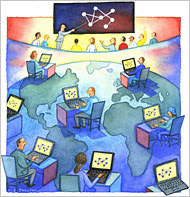
Technology usually gets people to their contact point. But will they collaborate as a team? Will they makes decisions as a team? Will they stay on course as a team?
Compass AE is a team collaborative process that enables the team to collaborate with direction. Regardless of the location of each member, they are always connected to the plan and the team.
Team connection from start to finish is the key to completing the goal.
###
THE MAZE MELTDOWN
Crash may virtually change commuting
Traffic hassles could put people on road to high-tech meetings
Ellen Lee, Chronicle Staff Writer
Sunday, May 6, 2007
Valerie Williamson was afraid the drive from her home in Belmont to San Francisco would be a nightmare, that the East Bay freeway meltdown would cause traffic havoc throughout the region. So, on Tuesday, she canceled a face-to-face meeting with a colleague in the city and got together instead in Second Life, an online virtual world.
Williamson connected with her colleague on Sheep Island, a Second Life location created by her employer, the Electric Sheep Co. The island houses the company's virtual headquarters, complete with a conference room, offices and tasteful decorative plants.
"I didn't want to go into the city so I just met him in-world," said Williamson,
a vice president of business development and marketing.
Admittedly, Williamson's case is special. Her company is in the business of creating online communities.
Nonetheless, she's far from alone. Many Bay Area workers, some encouraged by their employers, have turned to telecommuting now that normal travel routines have been upended.
It isn't clear just how many workers in the Bay Area have opted to telecommute since the freeway collapse.
But government agencies and private sector groups have been pushing it, and lighter traffic suggests more people are working from home. Many employers, including Wells Fargo, have called on their staff to use public transit and to talk to their supervisors about flexible hours and telecommuting from home or satellite offices.
Telecommuting may be one reason the traffic nightmares haven't been as bad as expected, said John Grubb, vice president of communications for the Bay Area Council.
"We've done a lot of work to prepare for these sorts of disasters in the past," Grubb said.
"The groundwork was already there."
The local boost to telecommuting comes as the trend is expanding nationwide.
Some 9.5 million people telecommuted in the United States in 2006, up slightly from 8.9 million in 2001, according to research firm IDC.
Another survey by CDW, a technology company, found that 33 percent of employees in the private sector and 75 percent of employees in federal jobs said they would be able to continue to work by telecommuting if a disaster closed their office. Businesses need to prepare by having plans for employees to keep working if they can't get to their offices, said Firooz Ghanbarzadeh, CDW's director of technology services and solutions.
Typically, data and telecommunications services that support telecommuting see surges in use following disruptions such as a freeway collapse or a snow storm, or major disasters such as the Sept. 11, 2001, terrorist attacks.
"Frankly what we find is that once people use the technology because they're forced to do it,
they can understand how they can use it in their daily work life," said Rick Faulk, chief marketing officer for WebEx, a Santa Clara online conferencing service.
Longtime telecommuters and newbies have an ever-larger array of technologies to keep them connected. Tools include cell phones, BlackBerrys, laptops, and video and audio conferencing equipment.
Telecommuters have also started to take advantage of a new generation of Internet collaboration tools, such as Second Life, created by San Francisco's Linden Labs, and Web sites that allow multiple users to share and edit documents online.
"You have so much work that is done on the computer today," said Claire Schooley, a senior industry analyst for Forrester, a technology research firm. "They make it very easy to connect."
What's more, she said, "The young people coming into the workforce expect to be mobile and connected all the time."
At the cutting edge are virtual worlds, which in addition to Second Life include sites such as There.com. Participants create avatars -- animated representations of themselves -- and use them to navigate the online world.
In Second Life, for example, they can give PowerPoint presentations, and stream audio and video in virtual conference rooms. Other participants can respond by clapping, cheering or raising hands to ask questions. Second Life is also testing a program that lets users communicate by voice, not just text.
Still in its early stages, businesses such as Sun Microsystems, IBM and Clear Ink, a digital marketing firm in Berkeley, have used Second Life to hold online meetings.
Promoters believe it allows for greater intimacy than e-mail and other traditional tools, adding a personal layer to long-distance business communication, whether your colleague or customer is across the country or just on the other side of a busted freeway.
"It's easy for telecommuters to feel disconnected from their co-workers," said Jeska Dzwigalski, a community developer for Second Life. Virtual communities allow "a different level of communication. It really does help when someone is physically distant."
Video conferencing, enhanced by more powerful compression technology, is proliferating as well, developing a following among those who aren't ready for avatars and want some face-to-face contact. A variety of companies offer video conferencing, including Pleasanton's Polycom and Berkeley's SightSpeed. Cisco Systems developed "TelePresence," so that users appear life-size on the screen and the participants sit around a single virtual conference table.
Still other online tools are making it easier for teams to put together documents or collaborate on projects, even though members are spread across multiple offices.
JotSpot, acquired by Google earlier this year, uses wiki technology, much like that of the popular online encyclopedia Wikipedia, to allow people to make changes in documents as
they work on projects online. Last year, Google also acquired Writely, now renamed Google Docs and Spreadsheets, which provides documents and spreadsheets that users can share over the Internet.
Redwood City's Saba offers tools that let users edit documents online, brainstorm on a virtual whiteboard and draw diagrams.
"It's about being able to have a natural experience even if you're not sitting in the same room," said A.G. Lambert, vice president of product marketing.
Edgar Blazona, co-founder of TrueModern, a Berkeley furniture business, was already using WebEx to keep in touch with shippers and factories in Thailand and India. Now he plans on using it more often instead of trekking to San Francisco. On Monday, instead of meeting his accountant in the city, the two logged onto WebEx to go over shipping details on a spreadsheet.
"We basically stayed put," said Blazona, a former furniture designer for Pottery Barn. The freeway collapse "opened the door for us. This is a reminder that this is something we should do regularly instead of making a trip over the bridge."
"Unfortunately," he added, "it took the falling of a freeway to open our eyes to something we're already using."
http://sfgate.com/cgi-bin/article.cgi?f=/c/a/2007/05/06/TELECOMMUTE.TMP
This article appeared on page D - 1 of the San Francisco Chronicle
Wednesday, October 24, 2007
Building, Connecting and Leading with the Tangible Vision


When there is a crisis, there is an opportunity. ..." --- Ancient Chinese Saying.
Determining the Opportunity Within the Crisis
The Compass team collaboratively uses the Tangible Vision to determine the possible forthcoming crisis and the possible opportunity that comes from it.
The challenge is finding the opportunity for that crisis. While the team is determining the opportunity, they ask the following question, "Does the opportunity enables us to maintain the advantage for a macro moment? ... The next question is what is the length of the macro moment? ...”
To develop this advantage, focus on an idea that gives a position of strength, efficiency and flexibility.
# # #
A team that efficiently builds and connect with their Tangible Vision, has the opportunity to control their destiny
# # #
"There is nothing more powerful than an idea whose time has come." .... Victor Hugo
We at C360 believes that Compass AE is the idea team collaborative tool for the 21st century.
/// *** Notes on the mentioned quote can be found here.
Tuesday, October 23, 2007
Future Trend of Global Business

To thrive in a global economy, it is important for a company to expand their influence at different locations. Having teams located at different locations is not good enough, the focus is synchronize the members of their distant project teams to operate as one unit. We believe that distant team collaboration is the tangible approach of doing global business.
With the current availability of web conferencing technology and information systems, project teams no longer need to meet at a central location. Having field offices will no longer be needed.
Members usually operate at home, client's office and coffee shops with web access. They connect and collaborate with each other with their Tangible Vision.
The project team that collaboratively build, connect and lead with their Tangible Vision is usually the key to a distant team project success.
###
Enduring attraction
From The Economist print edition
Success may come at a price, but no one seems put off
 | |
THERE is no single route to success as a financial centre. London has been at the heart of a great overseas trading network for centuries. New York rose as the gateway to the New World. Geneva and Zurich sit in a wealthy region and have benefited from favourable tax and regulatory policies. Chicago emerged as a global centre for futures and options because of its proximity to America's agricultural belt. Shanghai and Mumbai, both fledgling international hubs with big ambitions, serve vast, developing national markets. Places such as Singapore or Dubai have had to work hard to lure business to their shores. Yet for all their variety, these financial centres have certain things in common.
Saskia Sassen, a sociologist with a special interest in global cities, argues that one reason for the concentration of financial firms in a small number of centres is the social connection and information that comes from proximity with people in related fields. A second is the use of technology that (counter-intuitively) still filters a lot of apparently dispersed investment back to a few key electronic exchanges.
A third is the increasing globalisation of big corporations. As companies open new factories and national offices, their financial advisers follow. And as more banks and brokers move into financial centres, they attract related businesses such as law firms, accountancy practices and public-relations agencies. Not long ago big investment banks were represented in only a handful of cities. Zoe Cruz, co-president of Morgan Stanley, recalls that when she joined the firm in 1982 it had fewer than 3,000 employees in its main office in New York and two smaller ones in London and Tokyo. Today it has “flags in almost every country in the world” (actually, about 30).
Even though these days anyone with a laptop and a high-speed internet connection can trade financial products from anywhere, people prefer to cluster in the same old places. Trader magazine, a glossy publication designed for hedge-fund managers, currency traders and the like, recently named Chicago, London and New York as its top three cities for traders, though it also lists some less obvious ones in a top 20 that includes Miami and Las Vegas. The ranking was based on a range of factors, from trading infrastructure and taxes to nightlife and recreation facilities.
Quality of life is important to highly paid financiers, and successful centres such as London are changing constantly to keep delivering what it takes. Take a stroll through the narrow lanes of Spitalfields in the old East End of London and see the trendy market stalls and cafés that have arisen from the former wholesale fruit and vegetable market. On nearby Brune Street an historic building that formerly housed a soup kitchen “for the Jewish poor” is being converted into upmarket flats. The sign for Fournier Street, recalling the French Huguenots who settled here to escape religious persecution, is replicated in Bengali to cater for recent South Asian arrivals. Property prices have shot up, with ever more young financiers taking up residence here. The appeal of this traditional haven for working-class immigrants is its close proximity to the financial district, allowing financiers to walk to work.
Growing prosperity, a bigger tax haul and the cosmopolitan lifestyle of young financial professionals have injected new vitality into places like London, New York and Hong Kong. Yet there is also growing inequality, a steep rise in the cost of living and increasing pressure on middle-class families who are having to live ever farther away from city centres.
The income discrepancy between haves and have-nots in the world's financial capitals has not been this great since America's “gilded age” in the late 19th century, says Susan Fainstein, an expert on urban issues at Harvard. The trend began in the 1980s and has become stronger, despite temporary blips such as the dotcom bust in 2001. A report on wealth inequality in Britain in July found that the gap between rich and poor is now bigger than it has been for 40 years, with the proportion of middle-class households shrinking.
“People doing ordinary jobs, like firefighters, cannot afford to live in London,” says Chris Hamnett, a sociologist. The city now has a commuting zone stretching about 80 miles (129 km). Something similar is happening in Manhattan, where the price of an average property has risen above $1m.
Not all this urban gentrification can be laid at the door of financial services, but the new rich in the world's top cities are more likely to be hedge-fund managers than industrialists. Research recently by Mr Kaplan and Mr Rauh of the University of Chicago showed that in 2004 nine times as many Wall Street executives earned over $100m as did chief executives of public companies. The top 25 hedge-fund managers earned more than the chief executives of all the companies in the Standard & Poor's 500 combined.
As the financiers' money cascades across the cities where they live and work, it transforms everything from house prices to shopping patterns. Mr Hamnett draws an analogy with a multi-tiered water fountain, with water flowing first from the financial district to smart residential neighbourhoods, then to slightly less smart areas, and so on. On the other hand, if investment bankers' bonuses dry up, so will their lavish spending.
All this calls for a delicate balancing act from political leaders. The appeal of a vibrant financial sector is clear for politicians, ranging from Michael Bloomberg, New York's mayor, a former business tycoon who counts many of the city's top financiers among his personal friends, to Ken Livingstone, London's mayor, who used to be known as “Red Ken” for his far-left stance. They all understand that capitalism can be good for a city.Many in the financial elite are closely involved with their communities, raising funds for charities, supporting schools and making donations to political parties. Mr Doctoroff in New York points to public-spirited firms such as AIG, JPMorgan Chase and Merrill Lynch that have set up charitable foundations. London's financiers have also become more generous donors to charity.
Yet the recent backlash against private-equity firms in several countries illustrates the dangers of appearing to favour the financial elites, whether through tax policies or political access. Trade unions, consumer groups and politicians have railed against such perceived favouritism. Moreover, globalisation has meant that the financiers' ties to a “home town” are not as clear as they once were. Mr Doctoroff notes that despite executives' recent public-spiritedness, none is as involved in and committed to public causes in New York as David Rockefeller was decades ago.
Despite such drawbacks, most cities would kill for a thriving financial sector that produced highly paid jobs and juicy tax revenues. Big financial firms have fanned out around the globe and are not shy about telling politicians exactly what they want. Many of the things they are looking for—from good infrastructure to low taxes—are helpful for businesses of all kinds, not just financial firms. Being able to attract the right talent is critical too.
It is the mix of all these factors that has kept New York and London so far ahead of the rest. They may be shockingly expensive places to live, but top financiers clearly think they are worth it. And there are plenty of lesser financial centres that aspire to become more like them.
Copyright © 2007 The Economist Newspaper and The Economist Group. All rights reserved.
http://www.economist.com/displaystory.cfm?story_id=9753281&fsrc=RSSFriday, October 19, 2007
C360 Latest Endorsement (From Gerald M. Weinberg, the Ultra Consultant)
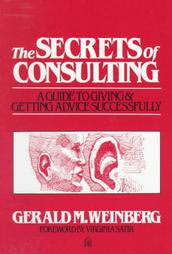
We recently received an unsolicited endorsement by Gerald Weinberg, the Ultra Consultant.
fyi- Mr ,Weinberg is the writer of many great consulting, system thinking and leadership classics (Secrets of Consulting, More Secrets of Consulting, More Secrets of Consulting; Are Your Lights On?: How To Figure Out What The Problem Really Is; Becoming A Technical Leader: An Organic Problem-Solving Approach; An Introduction To General Systems Thinking, Psychology of Computer Programming, etc.)
Believe all of his books are still the creme of the creme. The content of his books are still relevant in the 21st century and beyond. Refer it as a super text, a tangible classic. Recommend all of his books quite highly.
" … I very much appreciate being associated with sites I admire. I've made the link on my Consulting blog. … I know a bit about Chinese military strategy, but I'm no expert by a long way. I'm glad you are. … I don't think of myself as a guru. Just a person like you, who keeps eyes and ears open, and thinks about what he sees and hears. ... "
From then on, we exchanged notes on many topics
Strategy and Consulting
C360: "... While the science of strategy and consulting can be taught. It is the art of strategy and consulting that cannot be really taught. It is all about mindful awareness (as my poker buddies describes it "conscious awareness"). One either has it or don't. ..."
Weinberg: "True. Most people are sleepwalking, but I recognized immediately that you are not one of those."
Teaching Teamwork
C360: "... As mentioned on my site, we teach them how to build, connect and lead with a tangible vision for the first two days. Then we monitored them in building and connecting w/ their Tangible Vision on the 3rd day. Then it is up to the client to decide whether they want us to monitor their team through out the implementation of their Tangible Vision (project) ... "
Weinberg: "... Yes, they have to contribute that much awareness, otherwise they cannot even be dragged into teamwork. ..."
Compass AE Process
C360: "It (Compass AE) is based on our interpretation of collaboration from our understanding of the Chinese Strategy Classics. A team that collaboratively builds and connect with their Tangible Vision, will collaboratively lead with it as a team."
Weinberg: "... I have always felt great sympathy with Chinese and Japanese philosophy.
Apparently I have absorbed something, because my books are extremely popular in Japan and China. ..."

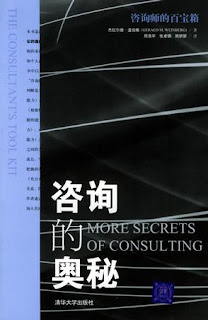
Leadership
Weinberg: "(From Colin Powell) Leadership is the art of accomplishing more than the science of management says is possible. ... "
C360: "Mr. Weinberg! Thank you very much for the endorsement."
Copyright:2007 © Collaboration360 Consultants (C360).
Copying, posting and reproduction in any form (without prior consent) is an infridgement of copyright.
Thursday, October 18, 2007
A Win for a Collaboration360 Client

Recently, worked with a client who started a catering service. Most of my consultation sessions with her via an instant messenger and phone calls. We assisted her in building a Tangible Vision for her company.
We used a strategic assessment module from our Compass AE process that enabled our client to assess and determine everything from planned outcome to specific details. We asked the right questions and was able to eliminate over 90% of the possible business development errors. She was able to determine everything from her company's start point, her company's goal and objectives, her company's strategic advantage, her competitor's strategic advantage, what marketing implements can she use against her competitors, etc..
Within a few months, she used it as the foundation to secure her first client.
In terms of operations, we applied the same process in preparing the client for her first catering event. After assessing the operation, she determined the possible operational project management errors and develop workarounds to the operational side of her Tangible Vision.
On the day of the client's first service event, there were no major obstacles that prevented our client from having a bad service day. She recently told me that the client was so happy that they renewed her contract for other events.
--- More to Come ---
Note: The origin of our "strategic assessments" module is based on an ancient Chinese essay that commented on chapter one of Sun Zi's Art of War- "Initial Calculations". It displayed a terse order of general strategic concepts listed from chapter 2-13 from the book "Sun Zi 's Art of War".
It took Collaboration360 a long time to understand the premise behind this writing. We transferred this order of concepts into a series of questions and used it to determine the meta-position of our clients and their opposition.
Copyright:2007 © Collaboration360 Consultants (C360).
Copying, posting and reproduction in any form (without prior consent) is an infringement of copyright.
Wednesday, October 17, 2007
How Does One Become a Ultra Class Strategist?
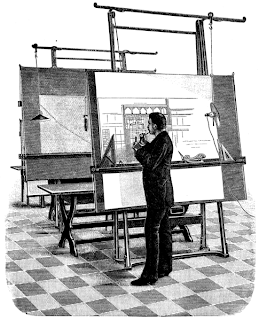
Following is a list of standard guidelines that this Chief Architect learned from his many years of strategizing:
- One must lose a lot before finally understand the true concept of strategy;
- Learned the importance of preparation before the implementation of the Tangible Vision begins;
- Learned the importance of having a competitive drive before and during theimplementation of the Tangible Vision;
- Learned the importance of always dissecting one's own actions and others on what wasdone right and what was done wrong;
- Learned the importance of a balanced gameplan;
- Learned the importance of strategic collaboration;
- Learned that strategy is a universal thing that only a few will understand; and
- Learned the importance of neutralizing the opposition before the game begins.
Copyright:2007 © Collaboration360 Consultants (C360).
Copying, posting and reproduction in any form (without prior consent) is an infridgement of copyright.
Monday, October 15, 2007
Great Teams are More Productive

A good reminder on why teamwork is important.
# # #
September 12, 2007
Mathematical proof that teams are more productive
Dear Bob ...
I liked this weeks' Keep the Joint Running ("The causes of greatness," 9/10/2007).
You have an assertion - that good employees who work together as a team outperform great employees who don't.
For a very long time I've been looking for a reference that provides some/any evidence for this, apart from anecdote or assertion.
I've read a heap of Jerry Weinberg's & friends work - this is one of their major planks. I believe it to be true,
- Teaming with curiousity
Dear Teaming ...
Nope. Like you, all I've heard is assertion and anecdote. Seems to be a chronic problem in the business press, doesn't it?
Looking at professional sports is the usual way to assess this. Of course, you then have to decide which sport to look at.
In the Ryder Cup, it's pretty much about which "team" has the great players.
In football, though, teamwork is essential or your star quarterback will still get creamed. (On the other hand, try asserting that the Packers without Brett Favre would still have won the Superbowl a few years back because they had teamwork. Not very convincing, is it?)
In the end, I think this is what mathematicians would call a "Q.E.D." situation. When work processes require cooperation among employees, those who know and trust each other will be able to spend more time and energy doing the work and less questioning and challenging each other. While we'd need actual evidence to compute exactly how much less time, the principle seems pretty solid based on the logic alone.
- Bob
http://weblog.infoworld.com/lewis/archives/2007/09/mathematical_pr.html?source=NLC-ADVICE&cgd=2007-09-12
| The causes of greatness | |
| 9/10/2007 | |
| | |
| |
| | |
 Depending on the business expert I'm listening to and the day of the week, I know three truths: Depending on the business expert I'm listening to and the day of the week, I know three truths:1. Good employees who work together as a team outperform great employees who don't. 2. Good employees with great processes outperform great employees with bad processes. 3. If an employee is irreplaceable you should immediately fire that employee. From first-hand observation I know that when it comes to Information Technology organizations:
Great employees can overcome organizational deficiencies to deliver useful results. They can't, by themselves deliver a great organization. That takes a lot more. The question of what makes a great organization tick is rife with superficial thinking. The usual approach is what you might call the "Tom Peters Fallacy":
Well, okay -- there is one: excellent leadership. That only works because I define "excellent leadership" as "Doing everything required to build a great organization," thereby begging the question. So ... what is required to make an organization great, as opposed to simply functioning? Leadership: A great organization does start with strong leadership, in a non-question-begging way. If there's no direction -- no focus, no goals, no plan, no definition of excellence, no clearly stated expectations for employees to live up to; no alignment of purpose and standards -- the employees will keep things going, but not much more than that. Great employees: Not every employee has to be a superstar, although all must be competent. Great organizations do need enough top-notch performers to demonstrate that high standards are achievable, not theoretical. Focus on achievement: The definition of "great employee" has been diluted through too many managers reading about "emotional intelligence." Employees who are focused on getting along will concentrate on how irritating their colleagues are. Employees who are focused on achievement will value their colleagues' contributions and ignore their eccentricities. Teamwork: Just as the definition of "great employee" can't ignore the importance of serious technical ability, it also can't ignore the importance of working and playing well with others, and of providing leadership in the trenches. Willingness to innovate: This is IT we're talking about. Information technology. The field where if you can buy it, it is obsolete by definition. IT organizations and everyone who works in them must be willing to try new technologies, processes and practices ... and even more important must be driven to constantly find improvements to the ones already in production ... or they stagnate. Willingness to not innovate: "State of the art" means "doesn't work right yet." Most of the time, the work required of IT is best achieved by extending what you have, not by chasing whatever is being hyped in this year's press releases, aided and abetted by publications hungry for advertising revenue. Evidence-based decision-making: Great organizations make decisions through the use of evidence and logic, not wishful thinking and listening to one's intestines. You'll note the usual buzzwords are notably absent. Governance, ITIL, CMM and all the other processes and practices (I used to call them Processes and processes) that are supposed to lead to inexorable success don't, in fact, lead to excellence. Excellent IT organizations do have them. Even more important, they are kept in their proper place -- as useful tools that help employees be as effective as possible. The best woodworkers have band saws, coping saws, lathes and routers in their workshops, and not just hammers and chisels, but their tools aren't what make them the best. Great IT organizations are the same. They practice good governance; follow consistent application maintenance, enhancement, design and testing methodologies; adhere to clearly defined change control procedures; and otherwise avoid making things up as they go along. Their processes and practices are important. They are, however, merely the signs of a great IT organization. They are not its cause. |
http://www.issurvivor.com/ArticlesDetail.asp?ID=631
Thursday, October 11, 2007
Compass AE: Communicate to Collaborate
Do you ever get messages that confuse you?
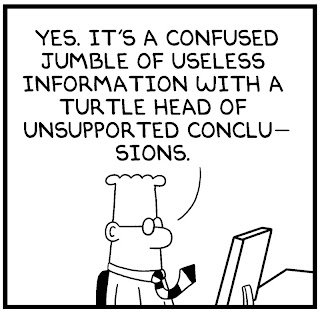 Do you ever get projects where the goal and objectives are vague and disconnected?
Do you ever get projects where the goal and objectives are vague and disconnected?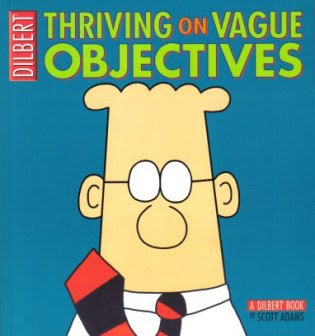
It is so difficult to thrive if the team's goal and objectives are vague. How can a team ever collaborate effectively when they spent most of the time arguing over the meaning of words?
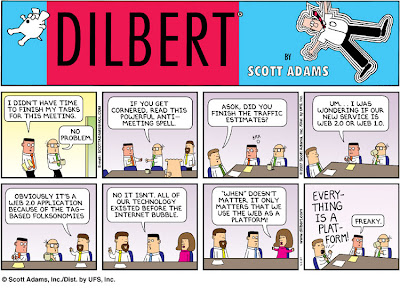 When reviewing the content of their Tangible Vision, the Compass team eliminates the vagueness by agreeing the specifics of each significant word.
When reviewing the content of their Tangible Vision, the Compass team eliminates the vagueness by agreeing the specifics of each significant word."The team that collaborate to communicate" will succeed over "the team that communicate to collaborate".
###
October 7, 2007
Preoccupations
E-Mail Is Easy to Write (and to Misread)
By DANIEL GOLEMAN
AS I was in the final throes of getting my most recent book into print, an employee at the publishing company sent me an e-mail message that stopped me in my tracks.
I had met her just once, at a meeting. We were having an e-mail exchange about some crucial detail involving publishing rights, which I thought was being worked out well. Then she wrote: "It's difficult to have this conversation by e-mail. I sound strident and you sound exasperated."
At first I was surprised to hear I had sounded exasperated. But once she identified this snag in our communications, I realized that something had really been off. So we had a phone call that cleared everything up in a few minutes, ending on a friendly note.
The advantage of a phone call or a drop-by over e-mail is clearly greatest when there is trouble at hand. But there are ways in which e-mail may subtly encourage such trouble in the first place.
This is becoming more apparent with the emergence of social neuroscience, the study of what happens in the brains of people as they interact. New findings have uncovered a design flaw at the interface where the brain encounters a computer screen: there are no online channels for the multiple signals the brain uses to calibrate emotions.
Face-to-face interaction, by contrast, is information-rich. We interpret what people say to us not only from their tone and facial expressions, but also from their body language and pacing, as well as their synchronization with what we do and say.
Most crucially, the brain's social circuitry mimics in our neurons what's happening in the other person's brain, keeping us on the same wavelength emotionally. This neural dance creates an instant rapport that arises from an enormous number of parallel information processors, all working instantaneously and out of our awareness.
In contrast to a phone call or talking in person, e-mail can be emotionally impoverished when it comes to nonverbal messages that add nuance and valence to our words. The typed words are denuded of the rich emotional context we convey in person or over the phone.
E-mail, of course, has a multitude of virtues: it's quick and convenient, democratizes access and lets us stay in touch with loads of people we could never see or call. It enables us to accomplish huge amounts of work together.
Still, if we rely solely on e-mail at work, the absence of a channel for the brain's emotional circuitry carries risks. In an article to be published next year in the Academy of Management Review, Kristin Byron, an assistant professor of management at Syracuse University's Whitman School of Management, finds that e-mail generally increases the likelihood of conflict and miscommunication.
One reason for this is that we tend to misinterpret positive e-mail messages as more neutral, and neutral ones as more negative, than the sender intended. Even jokes are rated as less funny by recipients than by senders.
We fail to realize this largely because of egocentricity, according to a 2005 article in the Journal of Personality and Social Psychology. Sitting alone in a cubicle or basement writing e-mail, the sender internally "hears" emotional overtones, though none of these cues will be sensed by the recipient.
When we talk, my brain's social radar picks up that hint of stridency in your voice and automatically lowers my own tone of exasperation, all in the service of working things out. But when we send e-mail, there's little to nothing by way of emotional valence to pick up. E-mail lacks those channels for the implicit meta-messages that, in a conversation, provide its positive or negative spin.
On the upside, the familiarity that develops between sender and receiver can help to reduce these problems, according to findings by Joseph Walther, a professor of communication and telecommunication at Michigan State University. People who know each other well, it turns out, are less likely to have these misunderstandings online.
These quirks of cyberpsychology are familiar to Clay Shirky, an adjunct professor in New York University's interactive telecommunications program. His expertise is social computing - software programs through which multiple users interact, ranging from Facebook to Listservs and chat rooms to e-mail. I asked Professor Shirky what all of this might imply for the multitudes of people who work with others by e-mail.
"When you communicate with a group you only know through electronic channels, it's like having functional Asperger's Syndrome - you are very logical and rational, but emotionally brittle," Professor Shirky said.
"I'm part of a far-flung distributed network that at one point was designing a piece of software for sharing medical data; we worked mostly by conference calls and e-mail, and it was going nowhere. So we finally said we'd all fly to Boston and get together for two days, just sit in a room and hash it out."
During that meeting, the team got an enormous amount of work done. And, Professor Shirky recalls, "because the synchronization by e-mail was so much better after the face-to-face piece, we actually hit the launch date."
He proposes that work groups whose members are widely dispersed but need to have high levels of coordination - say, a computer security team protecting a global bank - do not have to assemble everyone in one room to reap the same benefit. Instead, he suggests a "banyan model," after the Asian tree that puts down roots from its branches.
In this approach, he said, "you put down little roots of face-to-face contact everywhere, to strategically augment electronic communications."
Professor Shirky advised the I.T. head of a global bank to gather together one representative from disparate cities for a day or two and complete tasks. That way, when the security group in Singapore gets e-mail from the security people in London, someone will be more likely to know the sender, and sense how to read the information with less risk of misconstruing or discounting it.
CONSIDER, too, the "e-mail the guy down the hall" effect: as the use of e-mail increases in an organization, the overall volume of other kinds of communication drops - particularly routine friendly greetings. But lacking these seemingly innocuous interactions, people feel more disconnected from co-workers. This was noted in an article in Organizational Science almost a decade ago, just as e-mail was starting to surge. Saying "Hi," it turns out, really does matter; it's social glue.
As Professor Shirky puts it, "social software" like e-mail "is not better than face-to-face contact; it's only better than nothing."
Daniel Goleman is the author of "Social Intelligence: The New Science of Human Relationships" (Bantam). E-mail: preoccupations@nytimes.com.
Copyright 2007 The New York Times Company
###
http://www.nytimes.com/2007/10/07/jobs/07pre.html
Tuesday, October 9, 2007
Typical Project Management Outcome
Monday, October 8, 2007
The Benefits from Building, Connecting and Lead with the Tangible Vision

When a Compass team complete "the initial build and connect with their Tangible Vision" stage, the following actions occur:
- the top-down connections from goal to objectives are understood;
- the team trust are built; and
- the rules for strategic collaboration are defined.
Friday, October 5, 2007
The Benefits from Collaboratively Building and Connecting a Tangible Vision (2)

"This one who excels at warfare first establishes himself in a position when he cannot be defeated while not losing [any opportunity] to defeat the enemy. For this reason, the victorious army first realizes the conditions for victory, and then seeks to engage in battle. The vanquished army fights first. and then seeks victory . " - Sun Zi's Art of War : Chapter 4 Dispositions
With Compass AE, a project team leads with their Tangible Vision. They can perform the following:
* Determine the critical path;
* Avoid the negatives while focus on the positives;
* Foresee challenges;
* Position strategically;
* Shape the goal; and
* Collaborate through a Character-Based Leadership.
When those six steps are achieved, they are positioned to succeed.
# # #
Copyright: 2007 © Collaboration360 Consultants (C360).
Copying, posting and reproduction in any form (without prior consent) is an infringement of copyright.
Wednesday, October 3, 2007
Upcoming Event for the C360 Chief Architect

This coming December, the C360 Chief Architect of Collaboration360 Consultants will be speaking at a local businessman club in Oakland, California.
The topic is "Sun Zi's the Art of War: Applying Ancient Chinese Strategy to the Global Economy"
# # #
Following is the preliminary draft of his speech:.
Objective:
* Introduce to the audience the basics of Sun Zi Art of War
* Discuss the current role of Sun Zi in the global economy
Introduction
* Introduction of myself
* Who is Sun Zi
* Who has been using it
* Mentioned in the news media
* Number of books published
What is the "Ancient Chinese Strategy Mindset"
* Complete the grand goal by determining the critical path.
* Avoid the negatives and focus on the positives
* Formlessness and Foreknowledge
* Prepare by Positioning Strategically
* Shape the Goal
* Lead by Character.
Recommended Translations
Questions and Answers
Summary
- More to come -
# # #

